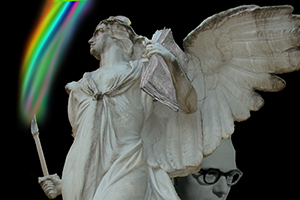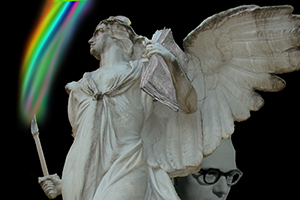
During the Last Days, in the 10th chapter of Revelation, a seventh, rainbowed angel, “as when a lion roareth,” commands seven thunders to speak seven unrecordable mysteries. Last Saturday, in the Community Hall of the Lafayette library, Pamela Freund-Striplen, the artistic director of the Gold Coast Chamber Players, commanded attention of several score patrons with seven revelatory treats for the ears and eyes. These were, first of all, the skillful renditions of the four musicians performing music inspired by that angel, Olivier Messiaen’s Quartet for the End of Time.
Three additions included an extended lecture on the work’s genesis by author and clarinetist Rebecca Rischin, and two souvenirs of the subject available for purchase. The first consisted of copies of Rischin’s book that she would sign during intermission. And as a final, visual memento, listeners could soak up the meaning of Moraga artist Camille Young’s original painting that was displayed on stage.
This Gold Coast concert is one of the more effective examples of the trend toward program multimedization. Lecture, performance, and painting provide triple the artistic output — and three times as much to review.
This Gold Coast concert is one of the more effective examples of the trend toward program multimedization. Lecture, performance, and painting provide triple the artistic output — and three times as much to review.
Lets begin with the lecture, which lasted nearly an hour and covered some fascinating material Rischin unearthed on the now-legendary premiere of the Quartet in a German prisoner-of-war camp on January 15, 1941. The story goes that Pianist Messiaen was interned there and discovered fellow musicians who played clarinet, a cello with only three strings, and a violin. Messiaen wrote his music for them, and attracted an outdoor crowd of 5000 to hear it in subfreezing temperatures. Rischin’s research showed that Messiaen later exaggerated these conditions (400 people heard it indoors; the cello had all its strings) and actually had written some of the music before arriving at the camp.
Rischin is not yet an engaging off-the-cuff speaker. But she’s a good writer, and wisely chose to read the bulk her speech, sparsely illustrated with low-resolution slides. The fascination of subject matter—the wartime circumstances, the personalities involved, the story of Rischin’s own adventure in gathering the facts—overrode these shortcomings for the most part. Unfortunately, in a move that could be viewed as more crassly commercial than intriguing, she tantalized the audience with hints that the story of the Jewish clarinetist’s escape from the camp was worthy of a novel, but then told them they’d have to buy her book to find out what happened to him. A brief summary of how he jumped a train and eluded capture would have been more gracious, and would not have diminished anyone’s curiosity.
Rischin was a welcome and innovative incorporation into the concert. But as lectures become ever more detailed and elaborate accompaniments to musical compositions, and as such become more worthy critical review in terms of the overall artistic experience, organizers of events should begin to insist on equivalent oral and aural quality levels. Standards are set too low right now for the former — a shame since a few weeks at Toastmasters would create improvements for some speakers that would require years of equivalent training among instrumentalists.
But it was Christopher Costanza’s deeply felt cello playing that provided most unforgettable moments, rising to an almost superhuman intensity at its climaxes.
Young’s painting was a nice touch. An acrylic done in portrait ratio, it depicted Messiaen’s 1941 program sheet near its base, with doves ascending from it beyond a barbed wire up to a sea illuminated by a Maltese cross of light at the top.
As to the music itself, the musicians put their all into it and produced exceptional results. Too often, the piece is played too dryly, with percussive loudnesses languishing in a sea of dry ethereality. This one had passion and guts, and was greeted with well-deserved bravos and a standing ovation. Kay Stern did a fine job on violin, with only a couple of minor intonation issues. Tony Striplen’s understated yet rhapsodic clarinet was a joy to hear. Yana Reznik on piano impressed with her ensemble work, and especially with her meticulously graduated, powerful and pointed passages depicting the lion-voiced angel. But it was Christopher Costanza’s deeply felt cello playing that provided most unforgettable moments, rising to an almost superhuman intensity at its climaxes. Clearly, he had taken what he called “on of the great opportunities of my life,” a chance to work on the piece with the composer in the 1980s, to heart.
The success of this concert was best typified by a non-musician who told me, “I had no expectations,” “The lecture was very helpful,” and, significantly, “I flee from Stravinsky, but this was special.”
She might indeed have fled, if, as some performers mistakenly do, it had been played like Stravinsky.

